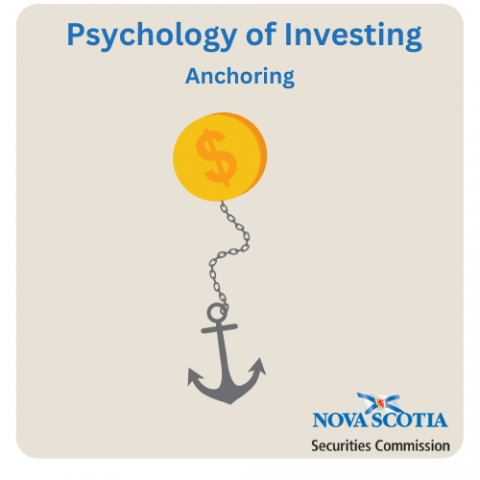Submitted by nsscadmin on

The fifth part of our psychology of investing series takes a closer look at anchoring. Have you ever been stuck on an original piece of information that has a strong effect on your decision making? It may have been anchoring.
Anchoring is a very common cognitive bias that affects many people without them even knowing it. Anchoring is the tendency for people to rely too heavily on the first piece of information they receive regarding a topic, situation, or decision. They become stuck or anchored by the information and unable or unwilling to move off it.
Anchoring can often be found when purchasing something. You may see an item at what you believe to be a high price, let’s say a TV that costs $2,000 for example. Later, you see a similar TV priced at $1,500 which you believe to be a good deal. You buy the lower priced TV due to the assumed savings despite not knowing if the TV is as good as the higher priced TV, or if it is even a good price at all. You are basing your decision solely on the price of the more expensive TV which is “anchored” in your mind.
A few other areas where anchoring commonly appears include financial negotiations, and price listing by restaurants or businesses.
In financial negotiations around salary, for example, you may ask for an exorbitant salary which sets what is known as a high anchor. This may make a lower salary, and possibly one you would have accepted all along, appear more appealing to the employer.
In price listings or restaurant menus, a business may put some of the more expensive products or dishes near the top or beginning of the product list or menu. This can make the lower priced products or dishes that follow more appealing even though they still may be expensive.
When it comes to investing, an investor can often get anchored to the price of a security which will cause them to make a poor decision. This can often happen when a person purchases and holds stocks. When asked to evaluate the price of a stock most people will look at the current price and make small adjustments up or down to determine what they believe is a fair price. Investors can also become anchored to the price they have paid for a stock and be unwilling to sell it if it drops below that price. This form of anchoring also has connections to loss aversion.
If anchoring has caused you to make poor investment decisions in the past or you believe you are susceptible to anchoring here are a few ways to protect yourself when investing.
Take a minute – Taking some extra time to make a decision can allow the anchoring effect to diminish as you collect more information and data. Instead of immediately following through with your decision based solely on anchored information, take some time, do some extra research and avoid allowing your bias to make your decision for you.
Do some research – This is partly connected to taking a minute, but as we said when your influenced by anchoring, you’re relying too heavily on one piece of information. If you think a security is cheap or a good value based solely on anchoring do some more research to back up or possibly refute that claim.
Question the anchor – If an anchored price is influencing your decision, question it. Is the anchor leading you to make a purchase you might not otherwise make?
Our series on the psychology of investing continues in two weeks with Part 6 which looks at confirmation bias.
